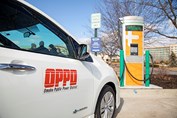
Electric Vehicles (EVs) are gaining popularity and becoming more prevalent across the country. Consumers have more choices of EVs than ever to choose from, and adoption continues to grow. As of December 2022, there were an estimated 2,000 EVs registered in the OPPD service territory (compared to only 400 in 2018). As interest in EVs grows in our area, OPPD is keeping an eye on the impact EVs will have on our community and service.
EV 101 - Basic Things to Know
Why choose an EV over a traditional combustion engine vehicle? People make the switch to electric for a variety of reasons, including reduced greenhouse gas emissions, savings on fuel and maintenance costs, and high performance. While up-front costs for an EV can be considered substantial, there are plenty of opportunities for incentives and rebates.
There are many types of EVs, from hybrid to fully battery-powered vehicles. The spectrum of available technologies and types can appeal to many different types of drivers.
Range Anxiety
A major concern with EVs is range anxiety, or the distance the vehicle can travel between charging. Typically, most battery-powered EVs can travel 200+ miles on a full charge. Extreme weather conditions and temperatures can affect the range of an EV, but they work well for many people’s day-to-day driving needs.
Charging
There are three main types of chargers that vary in cost and speed of charging.
- Level 1 Chargers Usually found in a personal residence for at-home charging and can typically use a standard home outlet. They charge slowly, adding only about 5 miles of range per hour charged. However, they have a low demand on the power grid and are the lowest cost to use.
- Level 2 Chargers Available at commercial stations and can be installed in a personal residence (but may need an upgrade to your home’s electrical system). They charge at a medium speed, adding about 25 miles of range per hour charged and are still low power grid demand.
- Level 3 Chargers (DC Fast Chargers) Only found at commercial stations. They charge at a high speed, providing a full battery charge in 30–60 minutes! However, they do come at a higher cost and put a higher demand on the power grid.


110–120 volt (V)
LOCATION:
Residential
CHARGE TIME:
40 hours
RANGE
5 miles/hr
CHARGING COST:
$3.39

220–240 volt (V)
LOCATION:
Residential
& Commercial:
CHARGE TIME:
10 hours
RANGE
25 miles/hr
CHARGING COST:
$3.39 (Residential)
$5.25 (Commercial)

400+ volt (V)
LOCATION:
Commercial
CHARGE TIME:
1+ hours
RANGE
100+ miles/hr
CHARGING COST:
$4.80
*These are rough estimates to give you an overview of the different charging levels. Your EV’s make, model and type of battery, as well as the type of charging station, can affect these numbers.
 Learn More!
Learn More!
Guide to Electric Vehicles (EVs)
Charging Location Map
OPPD Announces Five New EV Fast-Charging Stations
OPPD & EVs - A Powerful Relationship
Recent grant funding has allowed OPPD to install five new Level 3 DC Fast-Charging stations throughout our service area. These Level 3 chargers can fully charge a compatible EV in about 30 minutes. These charging sites (co-located with Level 2 charging stations) can be found at the following locations:
- Cabela’s (12703 Westport Pkwy., LaVista, NE)
- Casey’s General Store (210 E. 6th St., North Bend, NE)
- Casey’s General Store (1059 Washington St., Blair, NE)
- Casey’s General Store (946 11th St., Syracuse, NE)
- The public parking lot under Interstate 480 (17th & Cass Streets, Omaha, NE)
Many EV owners charge their vehicles while they are at home. These at-home facilities provide slower charging times compared to Level 3 sites. During peak hours of energy usage (in the early evening, especially during the hottest days of the year), this can put some strain on the power grid. Keep the following tips in mind when you’re planning to charge your EV at home:
- Be aware of what level of charger you have (most vehicles come with a Level 1 Charger), and make sure you upgrade your home’s electrical system, if needed.
- Try to charge your vehicle outside of peak hours, to lessen the load on the power grid. Plugging your car in when you go to bed, instead of right when you get home, can make a big difference. Many EVs have programming that allows owners to schedule their charging, which can be beneficial for all power customers.
Test your knowledge: How Much Have You Learned About EVs?
OPPD has been studying how EVs are being used and charged in our service territory for several years. We are constantly striving to find solutions to meet the needs of EV owners in Nebraska and continue to serve the increased demand on the power grid. We will continue to provide innovative, forward-looking solutions for our customer-owners, including new rate designs and product offerings. OPPD is working to ensure EVs make a smooth integration into our infrastructure.
Check out the links in the Learn More! box and peruse OPPD’s EV Guide for more information. You can also reach out to OPPD customer service by emailing customerservice@oppd.com, or calling 402-536-4131, if you have questions about charger installation at your home or to help find other available resources.
Other Related Articles and Resources
Federal Tax Incentives for EVs
Nebraska State Incentives for EVs
Building New Habits as EV Ownership Grows

